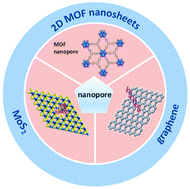Two-dimensional materials as solid-state nanopores for chemical sensing†
Abstract
Solid-state nanopores as a versatile alternative to biological nanopores have grown tremendously over the last two decades. They exhibit unique characteristics including mechanical robustness, thermal and chemical stability, easy modifications and so on. Moreover, the pore size of a solid-state nanopore could be accurately controlled from sub-nanometers to hundreds of nanometers based on the experimental requirements, presenting better adaptability than biological nanopores. Two-dimensional (2D) materials with single layer thicknesses and highly ordered structures have great potential as solid-state nanopores. In this perspective, we introduced three kinds of substrate-supported 2D material solid-state nanopores, including graphene, MoS2 and MOF nanosheets, which exhibited big advantages compared to traditional solid-state nanopores and other biological counterparts. Besides, we suggested the fabrication and modulation of 2D material solid-state nanopores. We also discussed the applications of 2D materials as solid-state nanopores for ion transportation, DNA sequencing and biomolecule detection.

- This article is part of the themed collections: 2021 Frontier and Perspective articles and Spotlight Collection: 2D Materials Chemistry


 Please wait while we load your content...
Please wait while we load your content...